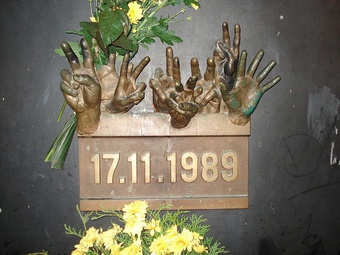
Velvet Revolution of 1989
The Velvet Revolution was a nonviolent revolution during November and December 1989 leading to the fall of the Communist regime and the beginning of democracy in Czechoslovakia. At the same time, Václav Havel became President of Czechoslovakia.
During the eighties, the entire Eastern Block expressed dissatisfaction with the economic and the political state of affairs, especially in countries experiencing worse economic situations.Everything started in Poland with the movement called Solidarity, which won the free elections in 1989. A similar wave started in Hungary, Romania and East Germany. Czechoslovakia then maintained a steady economic situation.
However, at the turn of 1988 and 1989, some anti-government demonstrations were organised, which was a start, even though repressed by the Police. Even Václav Havel was arrested during the so-called Palach's Week (demonstration on the occasion of Jan Palach's death). A student assembly had been planned on November 17th 1989, in order to honor the memory of Jan Opletal (murdered by Nazis in 1939). The state security forces had forbidden the originally planned march into the centre of the city, but they allowed the ongoing demonstration after the organizers turned towards Vyšehrad. In the evening, after the official end of the event, part of the demonstrators marched towards the Charles Square and then towards the National Theatre. In Národní Street, they were finally stopped by two units of the SWAT Police Forces. The demonstrators continued peacefully the nonviolent demonstration with the slogan "We Have Bare Hands" and the girls were even putting flowers on the shields of the SWAT team members. But then the SWAT started to beat down the demonstrators. They had nowhere to back off and chaos followed. Within an hour, the demonstration
was brutally repressed, many participants were injured, and some were even arrested.
It was in the news the day after and people started to express their disagreement. A general strike was planned. On November 19th 1989, the Civic Forum was formed, which formulated requirements concerning the resignation of the top government representatives and expressed support for the planned general strike.
Later the universities in Prague and the rest of Czechoslovakia followed the strike. Demonstrations spread nationwide. People did something that became symbolic and typical during demonstrations, they all clinked their keys. Václav Havel spoke publicly for the first time. The Communist leaders were thinking of deploying the Czechoslovak Army to stop the demonstrations but later changed their minds. On November 24th 1989, the entire Communist government led by Miloš Jakeš resigned. Three days later, the general strike began and the country came to a standstill. The borders to Western Europe were opened on December 4th 1989. On December 10th 1989, President Gustav Husák resigned and nominated the first non-Communist government since 1948. At the end of the year, Václav Havel was elected President unanimously and all strikes ended.
The Velvet Revolution brought democratization to the country, however, some problems arose. Political and economic changes in the country were unprepared and happened too fast. The Civic Forum was not ready to take over power. The subsequent transformation of the controlled economy into a market economy led to privatizations and restitutions which led to complications afterwards.
Nevertheless, the Velvet Revolution symbolises the end of an era, the end of power held by a single party and its name has become synonymous with nonviolent revolutions the world over.




